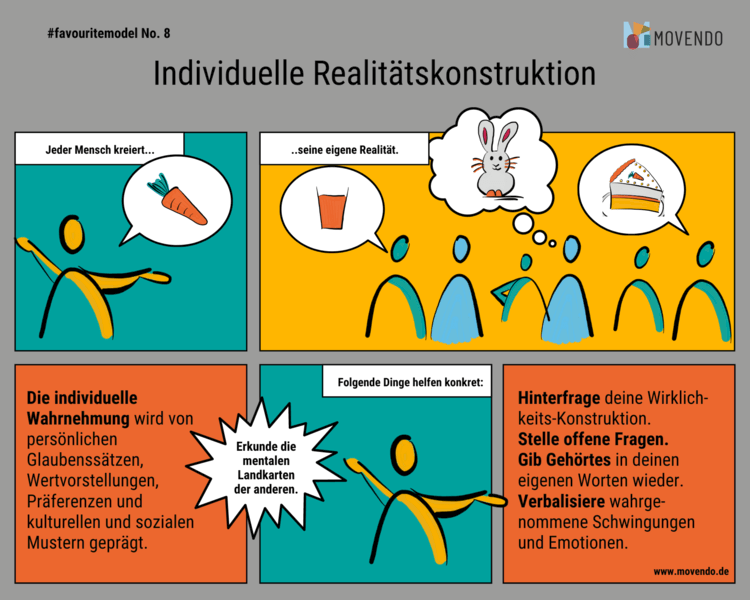Created by Andrea Böckle
#favouritemodel No. 8 – Individual reality construction

At any given moment, each of us receives a total of around 11 million bits of information via our five senses – hearing, sight, touch, smell and taste. Of this, the nervous system filters out around 200 bits that you can consciously perceive at the same time. The rest of the information is deleted.
These neurological filters are extremely important for you to react quickly. If you were to actually perceive all sensory impressions at every moment, you would simply go mad. At the same time, this process makes communication and interaction with others incredibly complex and challenging. This is because each person, as a unique observer of their environment, creates their own “individual reality” in this way.
Imagine we are both at the same time, in the same place and looking at the same situation. If each of us filters 200 bits out of the 11 million bits, then the probability that my selection corresponds exactly to your selection is zero. My selection is my small section of reality, my reality. While your reality is very likely to be completely different. Just as a map never represents the actual reality with all its details, our own mental maps also only represent sections.
What shapes your reality and how do I arrive at my reality?
What and how we perceive something is shaped on the one hand by our cultural and social patterns. For example, the topic of punctuality is interpreted and practiced differently in different cultures.
An employee whose former supervisor tended to micromanage is likely to respond to his new supervisor’s question about how he is progressing with the project with a very detailed report on the individual work steps. While another employee will only respond with “It’s going well!”.
In addition, personal beliefs, values and preferences that have formed over the course of our lives play a major role in our construction of reality: they distort, erase and generalize information from the environment and thus form your, as well as my, mental map of reality. In short, my reality is not your reality and vice versa.
This fact makes collaboration and especially communication between two or more people challenging in many areas. How can we come to a common denominator when we have a completely different view of reality?

How does my #favoritemodel help you?
If you realize that your view of things does not correspond to the perception and interpretation of your colleagues, this means that you will have to invest a lot more time in exploring the different mental maps and reconciling them with each other. This is the only way to ensure that you are on the same page and pulling in the same direction. In concrete terms, the following things can help you:
- Check your inner attitude – “The reality of others is different from my reality.”
- Question your construction of reality – what did you perceive with your senses and where do your experiences and beliefs distort your image and are they helpful or rather a hindrance at this moment? How would an outsider see the situation?
- Ask open questions – who, what, when and why? To find out more about the other person’s reality and to help them sharpen their mental map.
- Paraphrase and verbalize – summarize in your own words what you understood as the core message and what you heard and felt between the lines. Verbalize what vibrations and emotions you perceived.
- Use the camera and microphone during virtual meetings and ask your colleagues to do the same – this way you avoid your perception being further distorted by a technical filter.
Author

Andrea Böckle
Project partner




